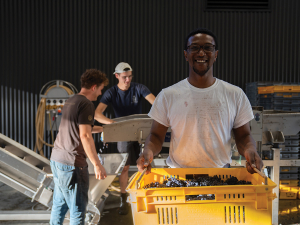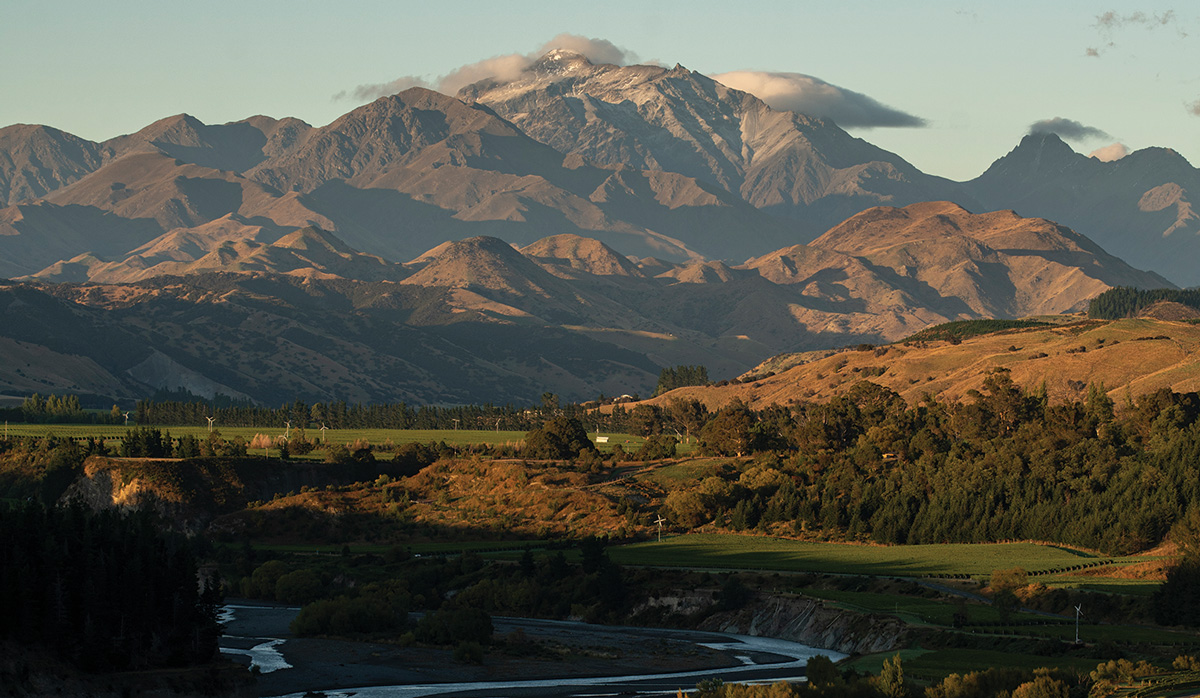Clive Jones Named 2025 NZ Winegrowers Fellow
As a young industrial chemist working in product development, Clive Jones would scan ingredient lists at the supermarket, "interested in what makes this product different from that".
 Daren Clark, Roots Fund Scholar from Greene County Virginia, hand sorting Pinot Noir. Photo Credit: Richard Brimer.
Daren Clark, Roots Fund Scholar from Greene County Virginia, hand sorting Pinot Noir. Photo Credit: Richard Brimer.
New Zealand's 2023 grape harvest came in 6% lighter than the heavy hitter of the previous year, with a total yield of 501,000 tonnes, down from 532,000 in 2022.
The latest harvest represents something of a Goldilocks zone, with enough wine to meet the market and take many companies through to the 2024 vintage, says Clive Jones, Chair of New Zealand Winegrowers (NZW) and General Manager of Nautilus Estate in Marlborough. "We probably have 12 months' supply and if we have 13 months' supply that's not a problem," he says, comparing the situation to 2021, when a small harvest and stellar demand saw a shortage of New Zealand wine in key markets. That led companies to bottle and ship the big 2022 crop (44% higher than the previous year) early. "The supply chain is reasonably full now and shipping is better, so we're probably back to a more regular ordering pattern."
NZW Chief Executive Philip Gregan says many in the industry will welcome the drop in harvest numbers. "I don't think anybody wanted to have another vintage the same size as last year. I think people were thinking a slightly smaller vintage would keep the demand supply balance more where it should be." He says pipeline filling in 2022 saw exports "early out of the blocks", but the supply situation has now normalised, and the industry can focus on its "underlying strength and growth of sales".
In Marlborough, vintage yields were down 5% on the bumper 2022 harvest, but the region nonetheless supplied 393,865 tonnes (81.3%) of the total vintage. Clive reports a nice balance between quality and quantity this year. "Quality was very, very strong at a base level with a nice level of highlights." In general, the wines from 2023 are "much better than 2022", with Pinot Noir (yielding 6.3% of the national pick) particularly strong, and Chardonnay (4.6%), Albariño and Pinot Gris (5.4%) "outstanding". Sauvignon Blanc, making up 78.1% of total production, is also "brilliant", he adds. From a Nautilus perspective "there wasn't a band tank in the winery", Clive adds, comparing that to 2022 when they had a more challenging time at blending. As a result consumers will find great quality and value in even the lower tiers of wines. "Our Twin Islands blend is probably the best we've had for 20 years."
Moreover, it was a Marlborough vintage many winegrowers enjoyed, after three extraordinarily difficult vintages in a row - 2020 for its Covid-19 national lockdown and rigorous rules for operating as an essential service; 2021 for its very light yields and tight labour supply; and 2022 for its record breaking crops, a vintage workforce decimated by the Omicron variant, and market clamouring for more wine.
In contrast, the region's 2023 vintage started out with tension over inclement weather, then surprised many with a second summer and lingering finish, Clive says. "Every vintage has challenges, but 2023 was back to a vintage we could enjoy and a reminder of why we do it". That was certainly not the situation for all growers, with North Island regions hammered by wet weather that culminated in Cyclone Gabrielle hitting harvest hard. But Clive notes the Marlborough harvest is vital for the ongoing health of the national industry. "The fact that Marlborough got the crop home from a New Zealand Wine Inc. perspective puts us in a good position."
James Dicey of Dicey Wines and Grape Vision in Central Otago is excited by the potential of the 2023 vintage, which is 5% down on the region's generous 2022 crop. He was pleased with the quality of 2022, but says this year's fruit, with smaller berries and lower yields, was even better. Rainfall just after veraison in 2022 resulted in an uplift in berry size, while a hot finish to summer carried the harvest home. The 2023 season looked on a similar path, thanks to the La Niña weather pattern, which is painful for much of New Zealand but favourable to Central Otago growers. However, a rainfall event this year happened later, so that berries were smaller with slightly higher quality, says James. “More intensity of flavour and more focus in the flavour of the wines in both aroma and taste.”
 |
|---|
|
Marlborough's Awatere Valley Vintage 2023. Photo Credit: Richard Brimer. |
In mid-March “La Niña turned off like a big light switch”, and Central Otago plunged into spring-like conditions, with some days moving from rain in the morning to sunshine after lunch to snow flurries in the evening. James had anticipated a concentrated harvest due to the lower yields, but the shift in weather resulted in one of Central Otago’s longest harvests ever. The cool weather made for a longer ripening period than 2022, “and we’re pretty excited about what that means”.
Hawke’s Bay recorded a 4% drop in yields for 2023, despite the impacts of the mid-harvest cyclone, which was disastrous for some. Hawke’s Bay Winegrowers Executive Officer Brent Linn says the data was a pleasant surprise, with potential for far greater losses had it not been for the late second summer that saw some of the region’s key varietals, especially later ripening reds, “presenting beautifully at vintage”. However, he notes that wine companies may feel demand pressure with the harvest decline, as surging export sales had seen many work through strong stock levels from the earlier “stellar” vintages. “Growers are looking forward to a return of an El Niño weather pattern and the opportunity to build back stocks.”
Philip says the South Island had an excellent vintage overall. And while the North Island had a tough year, producers were largely very happy with the quality of the 2023 harvest. “Regions across the North Island were hit hard by the unprecedented wet weather throughout summer, but their incredible hard work and commitment to producing premium quality wines means that consumers will continue to enjoy the distinctive wines that they know and love.”
There is some uncertainly for companies, given inflation and tax changes in markets like the United Kingdom, “and no one knows how that will impact demand for New Zealand wines”, Philip says. But he notes the New Zealand has historically performed well in economic “ups and downs”. And demand – especially for Sauvignon Blanc – remains strong, he adds. “Particularly out of North America."
The large 2025 harvest will exacerbate the wine industry's "lingering" supply from recent vintages, New Zealand Winegrowers Chief Executive Philip…
If you find a new consumer in a developed wine market, you are taking them from someone else, says Blank…
OPINION: Sauvignon Blanc was famously introduced to New Zealand by Ross Spence of Matua Valley, and then serendipitously planted in…